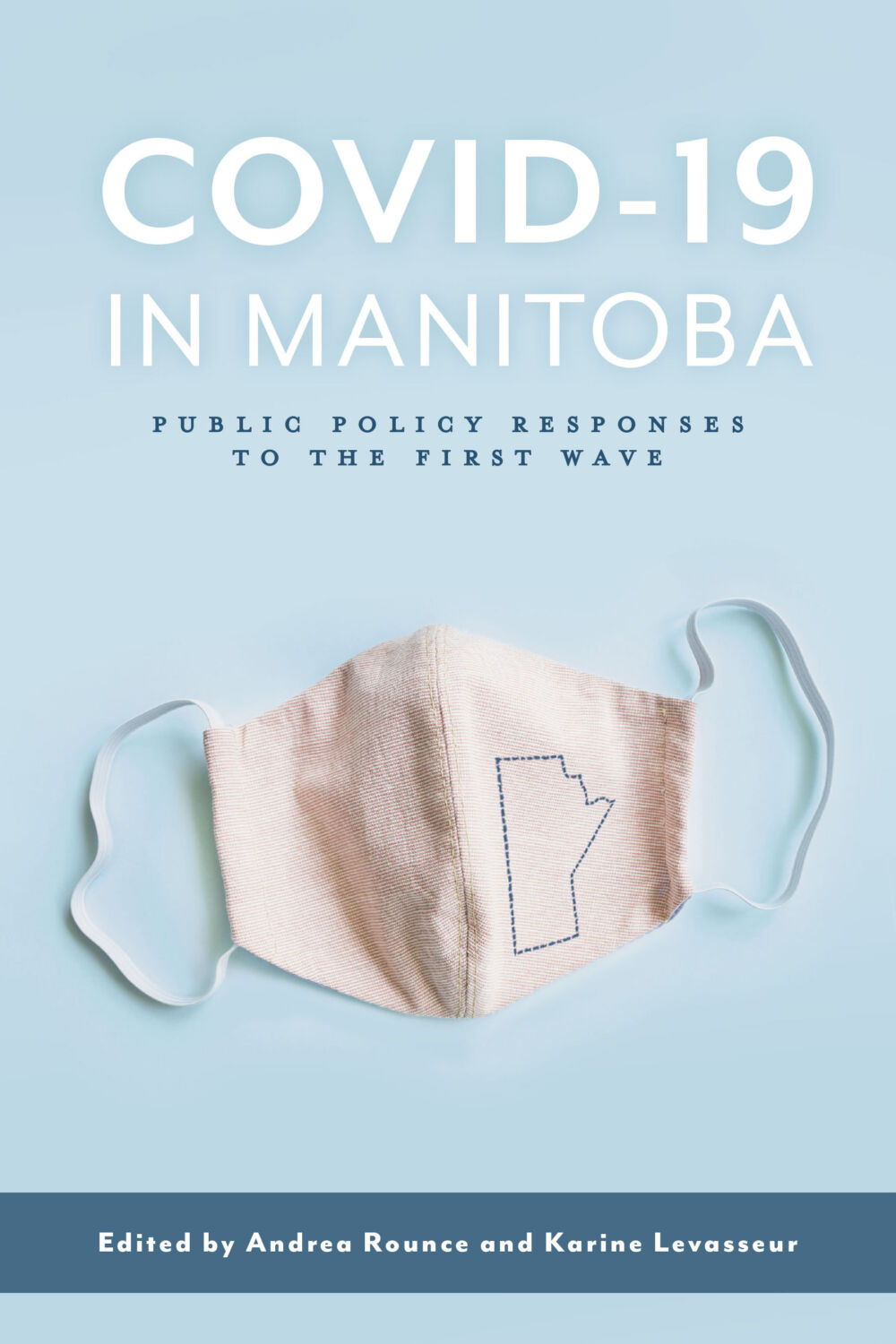An excerpt from COVID-19 in Manitoba: Public Policy Responses to the First Wave
By Andrea Rounce, Karine Levasseur, and Shannon Furness

On 12 March 2020, a sudden, yet unpretentious news conference led by Health Minister Cameron Friesen, Chief Medical Officer Dr. Brent Roussin, and Chief Nursing Officer Lanette Siragusa confirmed Manitoba’s first case of COVID-19.
The announcement heralded the end of “normalcy” for Manitobans. Soon to follow were closures of public institutions, private businesses, and, when possible, efforts to shift essential services online. One week later, another news conference, led by Premier Brian Pallister and Deputy Premier Heather Stefanson, declared a province-wide state of emergency, ushering in a new sense of urgency and rarely used government powers to protect Manitobans from the novel coronavirus and its devastating global reach.
As public administration researchers, we began to watch, document, and analyze how governments responded to the COVID-19 outbreak in order to protect Manitobans. This book seeks to understand how Manitoba fared during the first wave of the pandemic in the hopes of providing insight for the next waves of the pandemic. In terms of timing, this book focuses on the initial outset of COVID-19 in Manitoba from approximately March 2020 to August 2020. This is an important point: the timeline for this book is specific to the first wave of the pandemic, although there will also be references to developments that took place up to the publication date in November 2020. Of course, a complete post-mortem will be necessary to allow for a more holistic analysis of the pandemic rather than by waves.

Manitoba is not alone in confronting and articulating a response to COVID-19. While this volume primarily focuses on Manitoban public policy responses to COVID-19 during the first wave, it also seeks to address (where possible) the intersecting arrangement of Canada’s federal system of government and the pandemic’s implications for interprovincial, Indigenous, and community collaboration and response. In Canada, the Constitution delegates and divides responsibilities for various issues and activities among the provinces, territories, and the federal government.
The jurisdiction of health is complex: while provinces and territories administer health care, there is a significant role for the federal government as (1) coordinator through the Canada Health Act; (2) funder of health in the provinces and territories through transfer/ equalization payments; and (3) primary funder of health care for First Nations and Inuit peoples.

Ottawa provides crucial health-related information on the virus, exhibited with Dr. Theresa Tam’s regular briefings and the development of a COVID-19 tracking mobile app, and has poured funding into scientific research to develop both treatments and a potential vaccine. Additionally, the federal government plays a critical role in providing unemployment and underemployment relief through programs such as the Canada Emergency Response Benefit (CERB), but also financial supports for others, such as students and the non-profit sector.
While health-related responses to COVID-19 are largely provincially led, actions taken by the federal government impacted Manitobans and the operationalization of the provincial pandemic responses.
All things considered, this volume decidedly utilizes a provincial policy focus in order to best grasp the breadth and scope of the actions—and inaction—of the Government of Manitoba during the first wave of the pandemic, but analysis also includes the Government of Canada where necessary.
COVID-19’s wide-ranging impact has spanned every area of Manitoba’s governance process. Moreover, COVID-19 has challenged the conventional policy-making process that includes agenda setting, policy formulation, adoption, implementation, and evaluation. In these urgent times, governments have been under pressure to make swift decisions over matters addressing issues of life and death while launching urgently needed new programs despite the significant repercussions for future government actions. Meanwhile, these new policies need to lay the foundation for resiliency against the anticipated future waves of COVID-19 infections. While a federal system like Canada’s requires all actors to work collaboratively, the pandemic emphasized the scope of activities residing under provincial/territorial jurisdiction.
This book comprises twenty-seven chapters divided into three sections, with each chapter addressing various components of the pandemic. These chapters provide a starting point for discussion and analysis, but the reality is that not all topics could be assessed in this book. As such, much more research is yet to come on topics such as the impact of the virus on sex-trade workers, religious institutions, the seemingly daily changes in K-12 education, and many other areas.
Chapters are written by practitioners, students, scholars, and leaders who are experts in their craft, each advancing a perspective that contributes to the book’s diverse reflection on the responses of public policy as a result of COVID-19. As such, this book is not a typical academic publication. Rather, its interdisciplinary nature coupled with an understanding that there are different ways of expression mean that the book is a mix of both practitioner and academic perspectives. Given this diversity, readers are provided the opportunity to reflect on the lessons learned, and perhaps unlearned, as Manitoba—and societies across the world—prepare for future waves of COVID-19.
There is a particular theme that runs organically through the chapters in this book. We refer to this theme as a “mixed policy bag.” On the one hand, most authors acknowledge areas of success for the Government of Manitoba. In wave one, Manitoba became a model province with its relatively low rates of COVID-19 infections from March to July 2020,1 with many public organizations acting quickly to ensure employees could work from home and suspending services to help minimize the spread of the virus.
On the other hand, the government’s handling of the pandemic near the end of the first wave has been criticized. In late summer 2020, concerns arose related to the Government of Manitoba’s response to the virus, ranging from lack of enforcement, poor communications that sent mixed signals to citizens to “grow” and “restart,” and limited resources at testing sites. Infection rates increased in the Prairie Mountain Health Region, particularly in Brandon, Manitoba, during the month of August 2020. In late September 2020, Winnipeg and the surrounding areas also moved to the “Orange: Restricted” level of the pandemic response system. This prompted the Government of Manitoba to enact restrictions to slow the virus, including making masks mandatory and limiting the sizes of public gatherings. With higher rates of infections in November 2020, policy discussions ensued about a possible curfew for Winnipeg and the surrounding areas, followed by the introduction of the “Red: Critical” alert across the province.
Outside the health portfolio, many authors in this volume argue that the Government of Manitoba’s response (or lack thereof) reflects instances of policy failure. Authors outline the profound implications of how the Government of Manitoba responded to the pandemic, spanning political, social, and economic sectors: perceptions of Premier Pallister’s leadership, the role of the legislature, media and misinformation, reductions (or threat of cuts) to public-service employment and post-secondary education funding, and impacts on those working in the private sector. Significant challenges were faced by women (and families) reliant on limited/non-existent child and eldercare, people with disabilities, Indigenous peoples, renters and people experiencing homelessness, those deemed essential workers, and many others.
All authors point to areas for learning, identifying what government could and should do differently as the COVID-19 virus expectedly returns and resurges in the foreseeable future. Many authors point to the reality that the pandemic is both a public health crisis and an economic crisis, due to the recession it triggered. Authors provide insight into what successful public policy should look like and where the Manitoba government must go next in future waves of the pandemic.
We know that the pandemic is not over, and thus we will certainly be revisiting these issues again as a province.
Download the free ebook, COVID-19 in Manitoba: Public Policy Responses to the First Wave.
Posted by U of M Press
December 2, 2020
Categorized as Excerpt
Tagged community, coronavirus, covid19, education, health, manitoba, pandemic, policy, public policy, winnipeg
Mary Riter Hamilton honoured for Remembrance Day Happy pandemic holidays!
